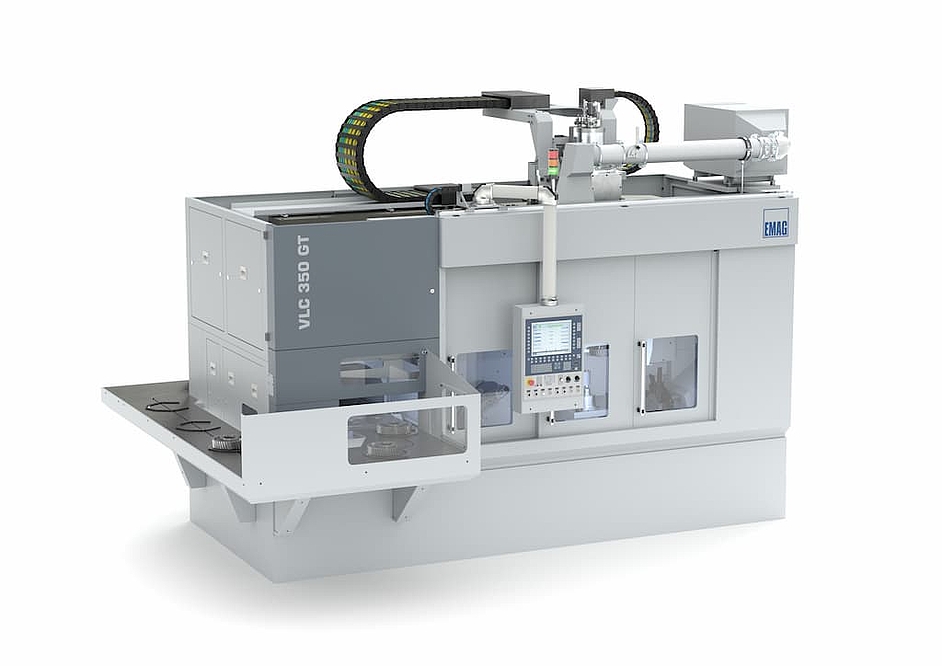07/16/2020 - Oliver Hagenlocher - Press
VLC 350 GT from EMAG: The perfect solution for the future of transmission and engine productions chucked parts
What will the cars on the street look like in the future? A new study by the Boston Consulting Group forecasts a mix of gasoline and diesel engines (48 percent), hybrid vehicles (33 percent) and completely electric (19 percent). For OEM’s and supply companies, this means that there will be a variety of conventional components, such as transmission gears, as well as new transmission components, produced in the future – in alternation and with a large amount of cost-pressure. The EMAG VLC 350 GT turning/grinding machine shows how this challenging task can be implemented, efficiently, in production. Different hard machining processes are performed on chucked components with a maximum diameter of up to 350 millimeters in succession and in a single clamping operation. Users benefit from a flexible solution with an excellent price-performance ratio.
Images
Large output quantities, precise machining processes and massive cost pressure— transmission manufacturing requirements are demanding, and will only become more demanding in the future as the automotive industry continues to evolve in this area. It is likely that in the future, there will be even more transmission variations to consider. How can manufacturers meet these challenges? EMAG provides a striking answer to this question with its VLC GT series, one of the most successful innovations released by the South German company in recent months. Two years ago, the VLC 200 GT was released - the “GT” in the name stands for “grinding” and “turning”. It hints at the main strength of this machine: the combination of grinding and turning (and additional processes) with the proven pick-up automation from EMAG, allowing for countless manufacturing solutions. This variety of technology allows the machine to cover the entire range of machining operations required for transmission components.
With the introduction of the VLC 350 GT machine to the market, EMAG is expanding on the capabilities of the VLC 200 GT, and can machine components up to 350 millimeters (14 in) in diameter. With this system, for the first time ever EMAG can offer the option of integrating a grinding spindle with an NC swiveling axis. This can hold, for example, cylindrical grinding elements for grinding internal bore holes. What is the overall strategy behind this new development? “Among other things, we are aiming at developing solutions for manufacturing processes with smaller batch sizes that inevitably involve many retooling processes,” explains Marina Manger from EMAG Sales. “In these applications, the fact that the machine includes several different grinding spindles from the outset is an obvious advantage. The machining area also provides plenty of space, so the machine is ready to handle any task.”
From Traditional Gears to Chucked Components with Internal Taper
The VLC 350 GT performs the traditional hard machining of gears—from hard turning of end faces to pre-turning of the bore hole, and outer synchronizing taper to finish grinding of these contours—as well as of many other chucked components with internal taper. For the latter, the internal grinding spindle with NC swiveling axis pays off:
- End face turning: Loading (and subsequent unloading) is performed at high speeds with a pick-up spindle. The machining operation starts with hard turning of the end faces.
- Contour turning: Depending on the component geometry, inner contours (with one or two tapers), a cylindrical borehole and the outer synchronizing taper can be pre-turned in the second step.
- Inner contour grinding: The use of a cylindrical grinding element on the swiveling NC axis makes it possible to machine various internal taper angles. To do this, the grinding spindle is swivels precisely to the required angle in each case. Any required boreholes are completed like this (with a zero-degree grinding angle).
- Outer counter grinding: The final operation consists of grinding the outer synchronizing taper with the external grinding spindle.
“If a customer wants to machine a wide range of parts with many different bore holes, we can also integrate two internal grinding spindles in the VLC 350 GT,” says Marina Manger. “The reason for this is that smaller boreholes require the grinding element to operate at higher speeds, while large borehole diameters instead require a lower speed. In certain circumstances, this cannot be achieved with a single grinding spindle.”
Shorter Cycle Times—Decreasing Tool Costs
In addition, it is crucial that the combined machining operation consisting of (hard) turning and grinding ensures fast processes and high machining quality: The residual machining allowance after turning is only a few millimeters. The grinding process with corundum or CBN grinding wheels is significantly shorter. Considering the low residual machining allowance, the specification of the grinding wheel can also be geared more specifically toward final quality. An integrated measuring probe checks the diameter and length of the component after the process. In addition, a linear motor in the X-axis ensures short chip-to-chip times, because it moves the components to the machining position particularly fast.
Flexible Configuration Allows for Many Solutions
There are a variety of possible applications for the VLC 350 GT, with respect to desired production volume for example, as Marina Manger stresses: “Owing to its performance, the machine is perfect for medium and high-volume production. Its ease of tooling, including two large doors and accessible tools, as well as its flexibility in terms of configuration, as mentioned above, nevertheless also make it interesting for small batch sizes with frequently changing production tasks.” The machine can be loaded manually or integrated in production lines.
Last but not least, EMAG offers the VLC 350 GT to its customers with an attractive price-performance ratio. This is made possible by using tried-and-tested standard components. “We are very optimistic that this approach will establish itself in the market,” concludes Manger. “The combination of fast processes, low tool costs and flexible application options has already convinced many production planners of the predecessor machine.”
Downloads
Contact

Oliver Hagenlocher
Area
Press and Communication















